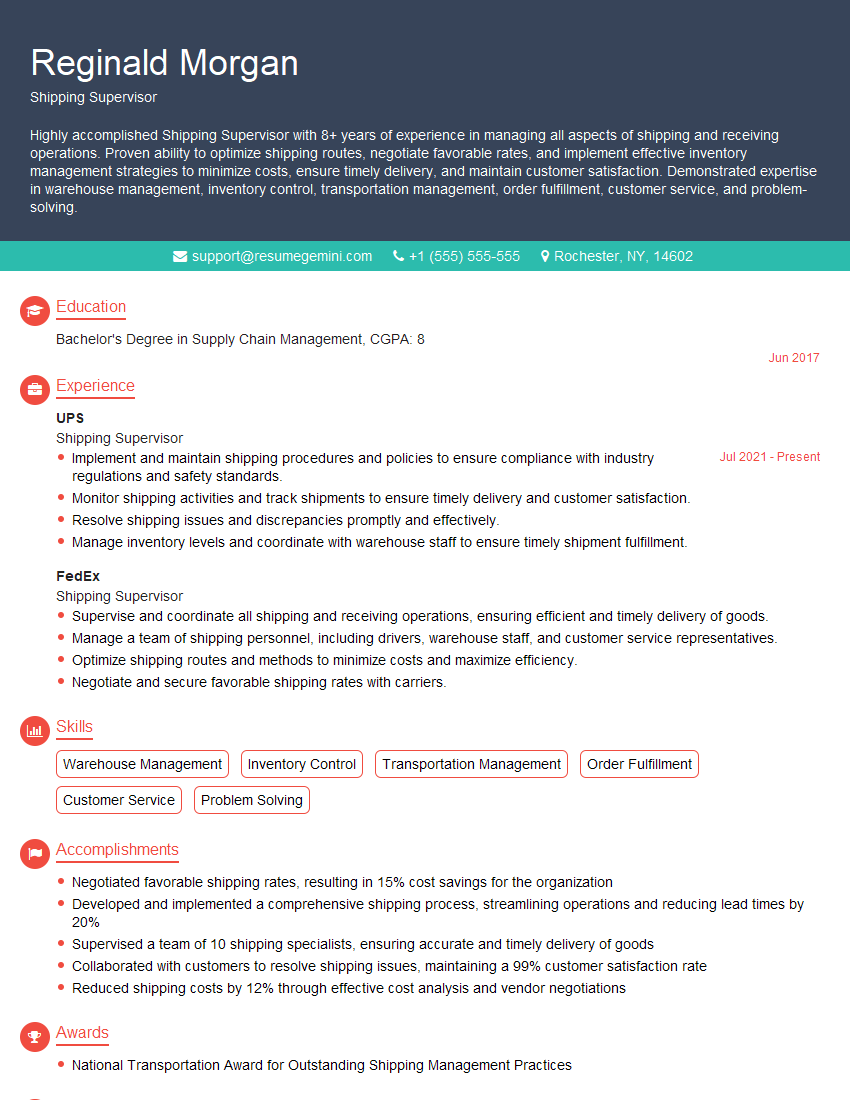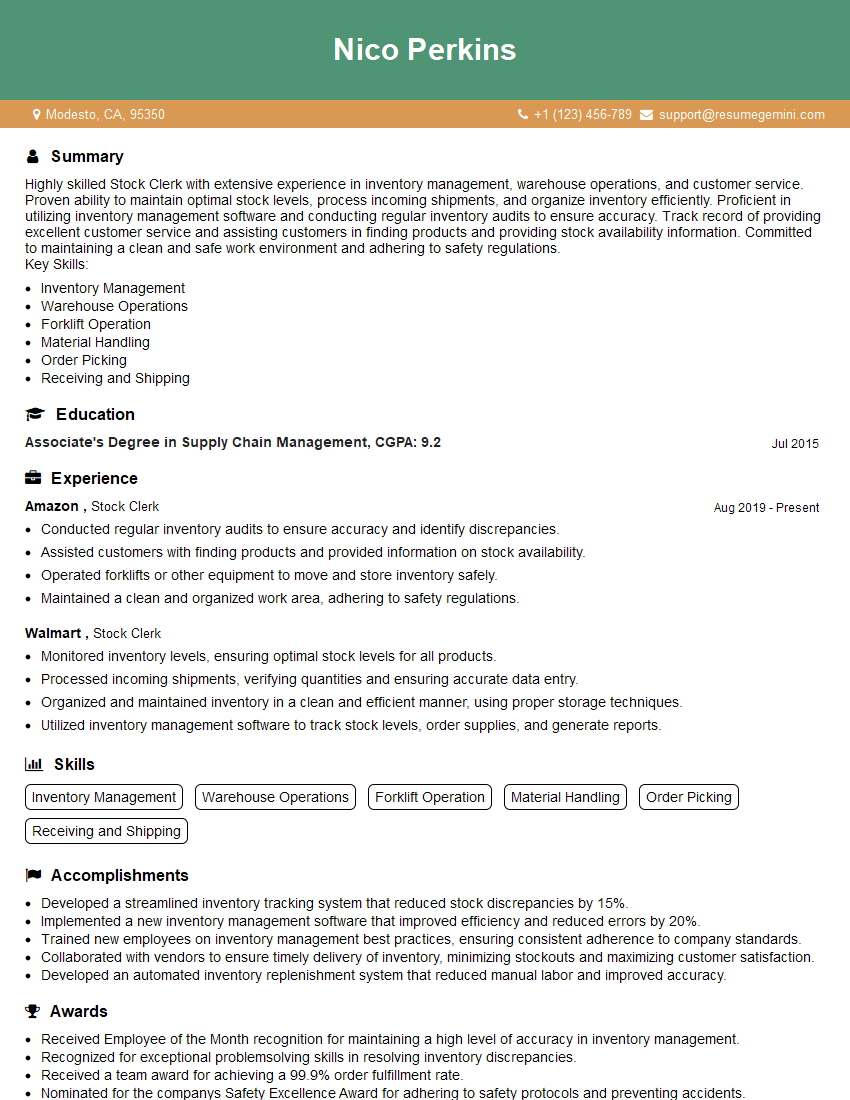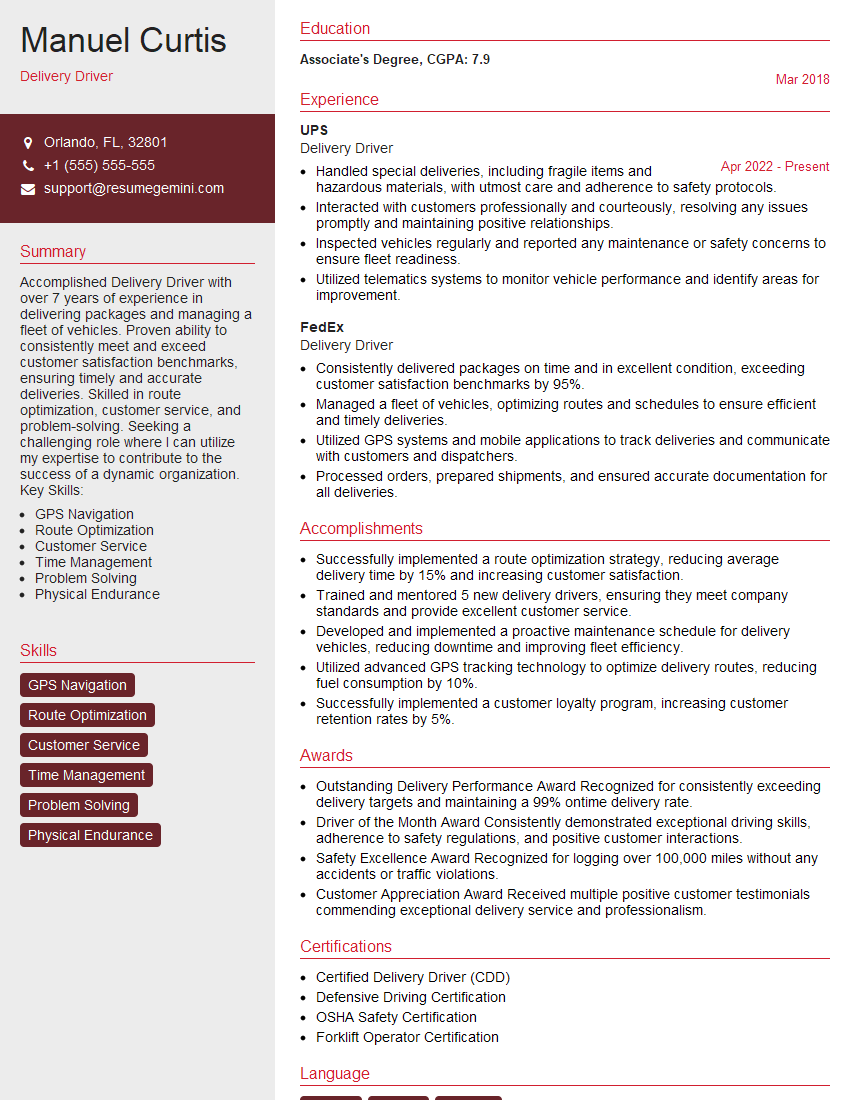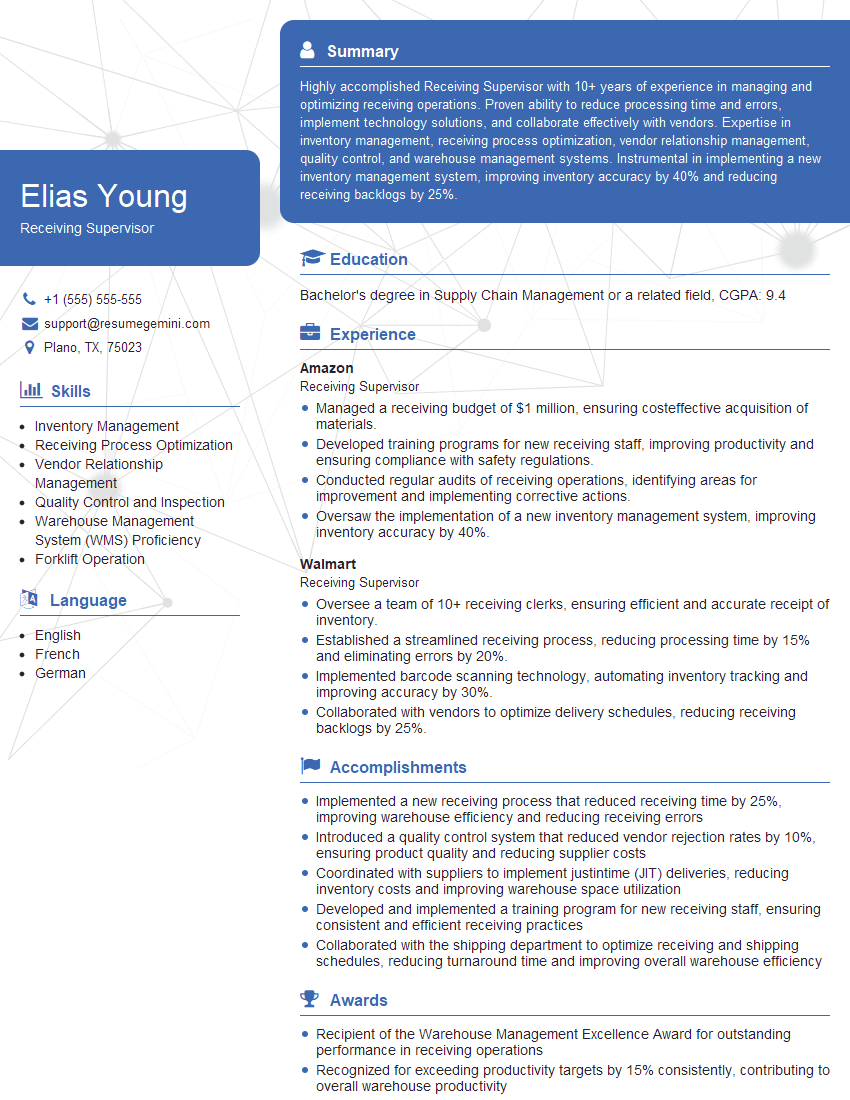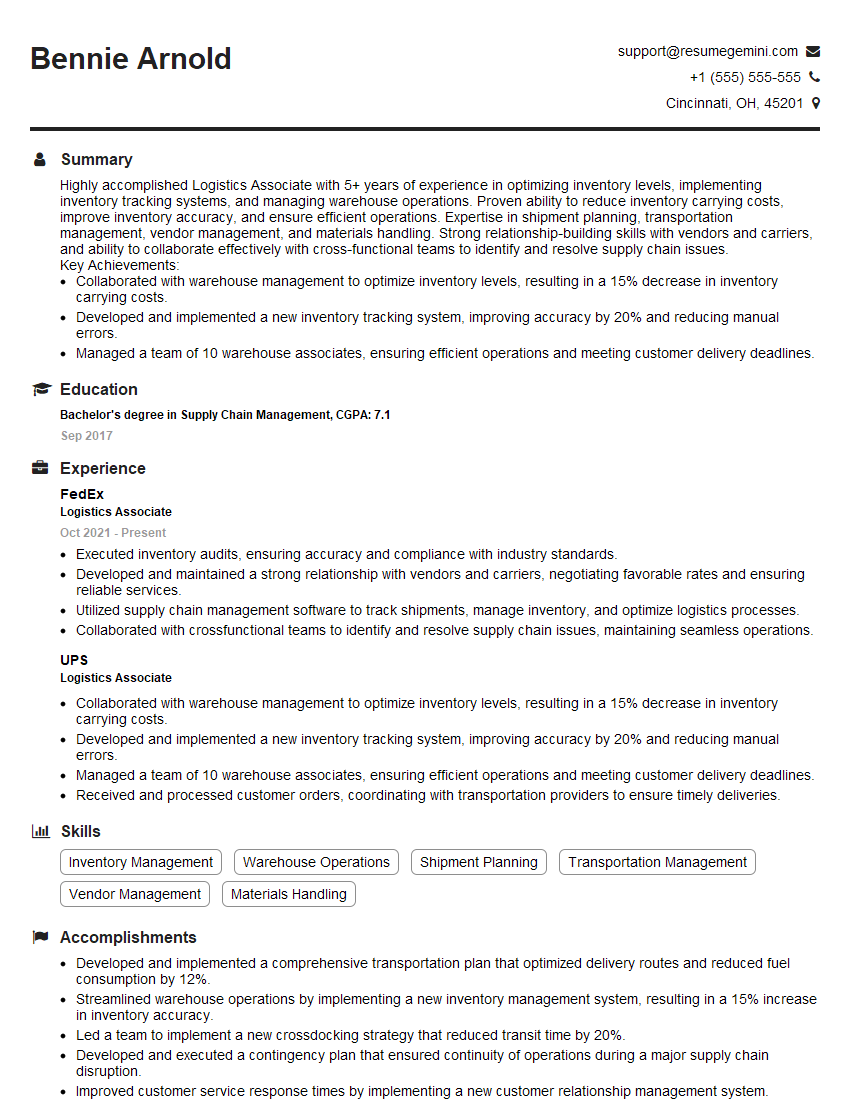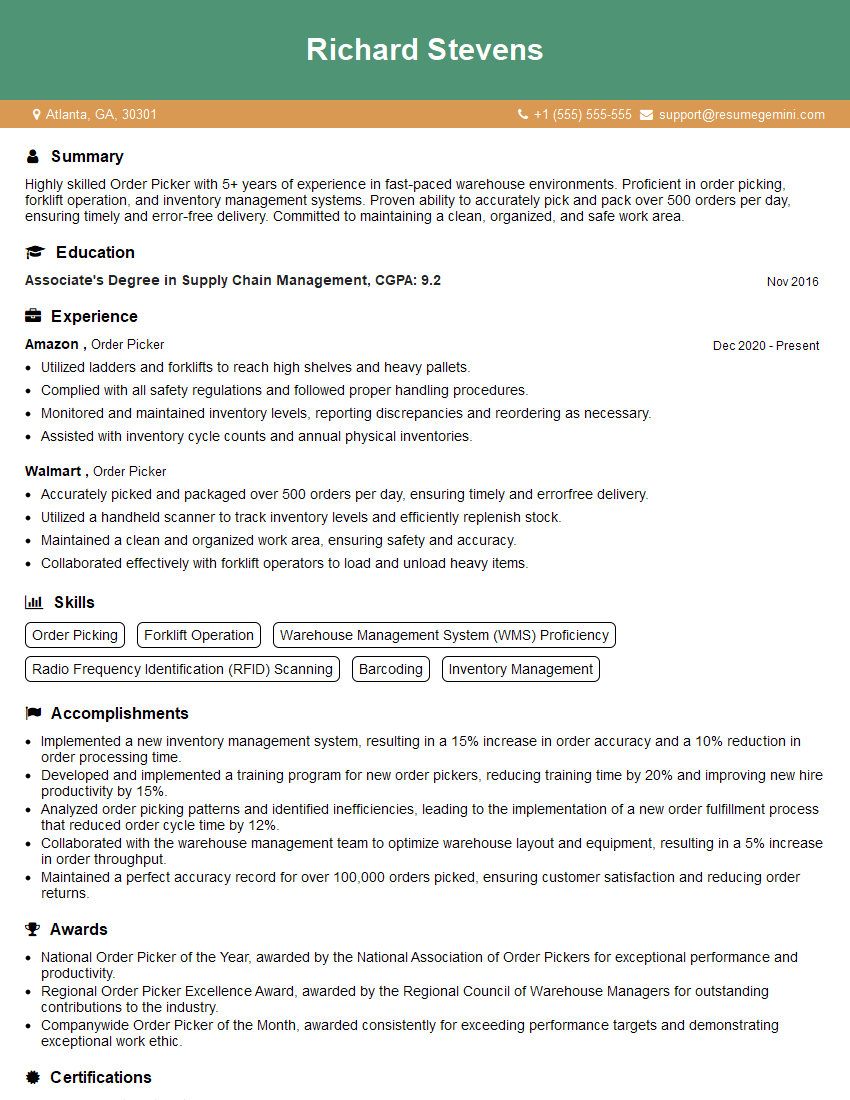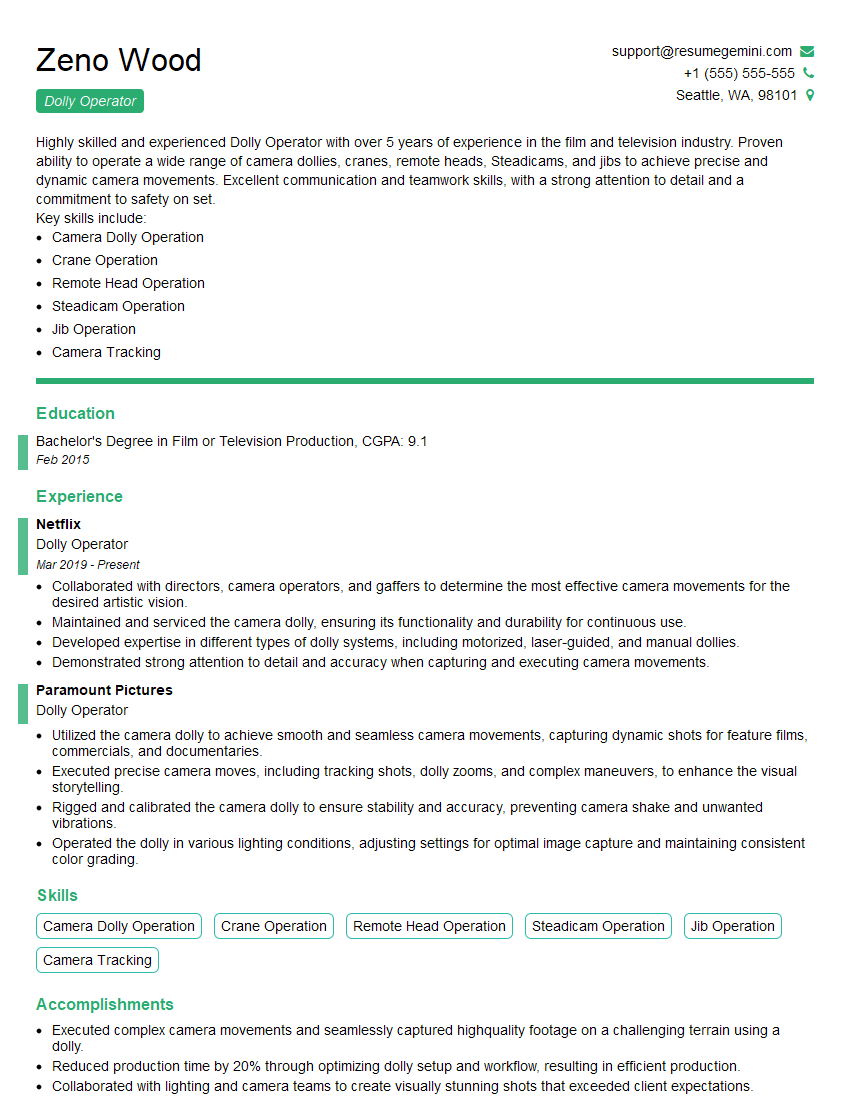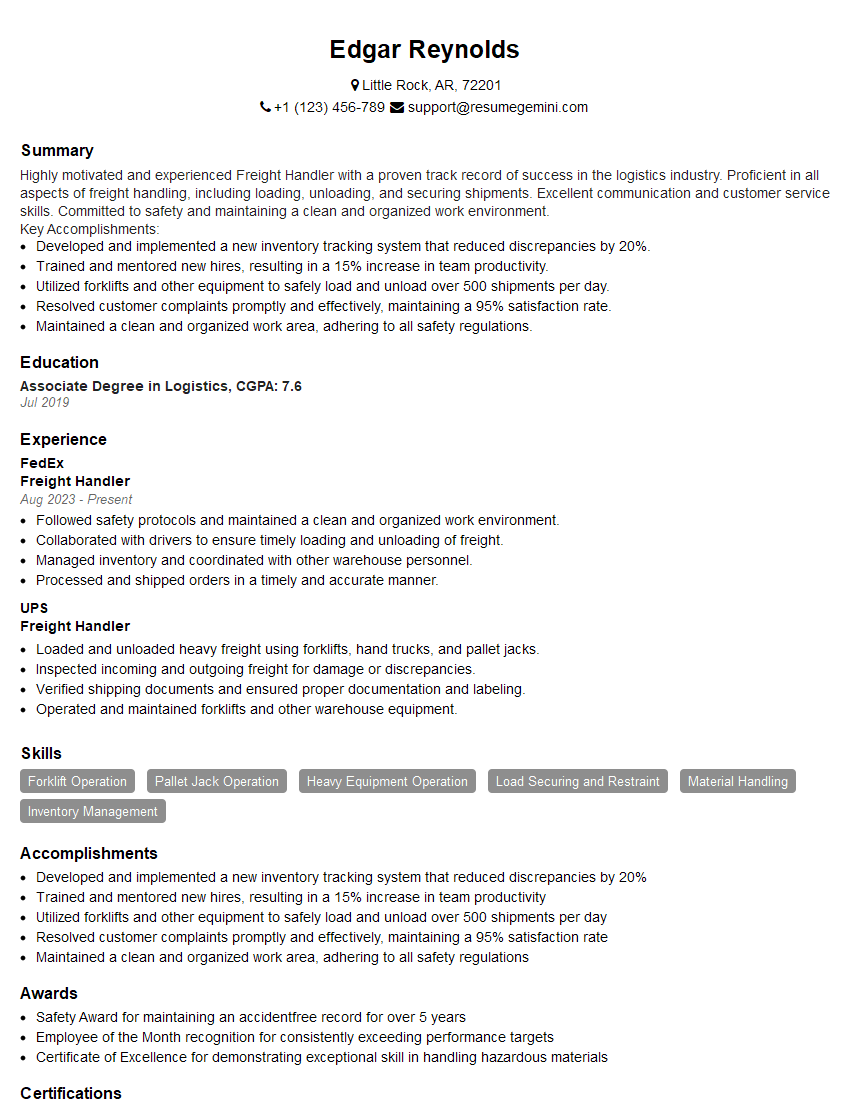Interviews are more than just a Q&A session—they’re a chance to prove your worth. This blog dives into essential Dollies and Hand Trucks interview questions and expert tips to help you align your answers with what hiring managers are looking for. Start preparing to shine!
Questions Asked in Dollies and Hand Trucks Interview
Q 1. What are the different types of hand trucks?
Hand trucks come in a variety of types, each designed for specific tasks and load capacities. The most common are two-wheeled hand trucks and four-wheeled hand trucks (also known as dollies). Beyond these basic types, there are also specialized hand trucks such as:
- Heavy-duty hand trucks: Built to handle significantly heavier loads than standard models, often featuring reinforced frames and larger wheels.
- Stair climbers: Designed for navigating stairs and uneven terrain, these typically have a set of smaller wheels at the top in addition to larger wheels at the base.
- Appliance hand trucks: Specialized for moving large appliances, with features like straps or padded surfaces to protect the appliance.
- Platform hand trucks: These offer a larger, flat platform for carrying multiple items or irregularly shaped loads. They often are four-wheeled.
- Sack trucks: Designed specifically for carrying heavy bags or sacks, typically with a trough-like platform and sometimes a braking mechanism.
The choice of hand truck depends entirely on the weight, size, and type of load being moved, as well as the terrain.
Q 2. Explain the proper technique for using a two-wheeled hand truck.
Using a two-wheeled hand truck correctly is crucial for safety and efficiency. Think of it like steering a bicycle, but with a much heavier load. Here’s the proper technique:
- Assess the load: Ensure the load is balanced and centered on the truck’s platform. Heavier items should be placed lower for better stability.
- Lift the load: Use proper lifting techniques to avoid injury. Bend your knees, keep your back straight, and lift with your legs. Avoid twisting your body.
- Position yourself: Stand behind the hand truck with a firm grip on the handles. Maintain a balanced posture.
- Tilt and maneuver: Slightly tilt the handles backward to initiate movement. Keep the load balanced to avoid tipping. Steer with subtle adjustments of the handles, moving smoothly and avoiding sudden jerks.
- Control speed: Move slowly and cautiously, especially on uneven surfaces or around obstacles.
- Use ramps: Use ramps where necessary to navigate stairs or curbs, maintaining control of the load throughout the process.
Example: Imagine moving a heavy box of books. Position the box centrally on the truck, lift carefully, maintain a firm grip, and move slowly, adjusting your grip and body position to counteract any imbalance.
Q 3. Describe the proper technique for using a four-wheeled hand truck.
Four-wheeled hand trucks, or dollies, are generally easier to maneuver than two-wheeled trucks, particularly over longer distances and on flat surfaces. However, they require different techniques for effective use.
- Load Securely: Ensure the load is balanced and secured to the platform, using straps or other restraints if needed. Distribute weight evenly.
- Proper Grip: Depending on the dolly’s design, you might have a handle or push bar. Maintain a firm, comfortable grip.
- Steady Pushing or Pulling: Push or pull the dolly smoothly and steadily. Avoid jerking movements that can cause the load to shift or the dolly to tip.
- Maneuvering Corners: When turning corners, go slowly and adjust the direction carefully. You may need to push from a slightly offset position.
- Obstacles: Navigate obstacles by lifting the front or back of the dolly slightly if necessary to avoid scraping or tipping.
Example: Moving a large, heavy washing machine. Place it firmly on the platform, securing it with straps if required. Push it slowly and steadily, keeping your posture upright and balanced.
Q 4. How do you safely load heavy objects onto a dolly or hand truck?
Safe loading is paramount to prevent accidents. Always follow these steps:
- Assess the weight and size: Ensure the load is within the hand truck’s capacity. If unsure, use a heavier-duty model.
- Use proper lifting techniques: Lift with your legs, not your back, keeping your back straight. Get help if the load is too heavy for one person.
- Balance the load: Distribute weight evenly on the platform. Heavy items should be positioned lower for stability.
- Secure the load: Use straps, ropes, or other securing mechanisms to prevent shifting during transport. This is especially critical for uneven or tall loads.
- Check stability: Before moving, ensure the loaded hand truck is stable and balanced.
Example: Moving a refrigerator. Use a heavy-duty appliance dolly, position the fridge centrally, use straps to secure it, and have assistance for the initial lift and moving process.
Q 5. How do you safely unload heavy objects from a dolly or hand truck?
Unloading should be as carefully executed as loading:
- Position carefully: Place the hand truck near the desired unloading location, ensuring stability.
- Secure the surroundings: Clear the area of any obstacles that could cause tripping or accidents.
- Controlled lowering: Slowly lower the load, using your legs to control the descent and preventing sudden drops.
- Safe transfer: Carefully guide the load to its final destination. If heavy, get assistance.
- Remove straps or securing devices: After placement, remove all straps or other securing mechanisms.
Example: Unloading a washing machine. Position the dolly near its final spot, slowly lower the machine using controlled movements, guiding it to its final location, then remove the securing straps.
Q 6. What are the safety precautions you should take when using a dolly or hand truck?
Safety should always be the top priority when using hand trucks and dollies.
- Inspect before use: Check for any damage to wheels, handles, or frame. Do not use a damaged hand truck.
- Use appropriate footwear: Wear sturdy, closed-toe shoes to protect your feet.
- Lift with your legs: Always use proper lifting techniques to avoid back injuries.
- Get help when needed: Don’t hesitate to ask for assistance with heavy or awkward loads.
- Maintain a clear path: Keep the area around you clear of obstacles to prevent tripping hazards.
- Be aware of your surroundings: Pay attention to other people and objects in the vicinity.
- Avoid rushing: Move slowly and carefully, especially on uneven surfaces.
- Use ramps: When moving loads up or down stairs, use appropriate ramps to minimize the risk of accidents.
Remember: Safety is not just about avoiding injuries; it also contributes to efficiency. Preventing accidents saves time, resources and potential legal repercussions.
Q 7. What are the limitations of using a dolly or hand truck?
While incredibly useful, hand trucks and dollies have limitations:
- Weight capacity: Each hand truck has a maximum weight limit. Exceeding this limit can lead to damage or accidents.
- Maneuverability: They can be difficult to maneuver in tight spaces or on uneven terrain.
- Load size and shape: They are not suitable for all sizes and shapes of loads. Irregularly shaped objects may require special techniques or equipment.
- Stair negotiation: Standard hand trucks are not designed for stairs. Specialized stair climbing equipment might be necessary.
- Distance limitations: Moving very heavy loads over long distances may require alternative methods such as forklifts or pallet jacks.
Understanding these limitations helps you choose the right equipment for the job and employ safe working practices.
Q 8. How do you select the appropriate dolly or hand truck for a specific task?
Selecting the right dolly or hand truck depends entirely on the load’s weight, size, type, and the terrain you’ll be navigating. Think of it like choosing the right tool for a job – you wouldn’t use a screwdriver to hammer a nail!
- Weight Capacity: Always check the dolly’s or hand truck’s weight capacity. Overloading is dangerous and can lead to damage or injury. Add a safety margin; if your load is close to the maximum weight, opt for a higher-capacity model.
- Load Type: Appliance dollies are designed for heavier, less maneuverable items like refrigerators. Furniture dollies are often better for lighter, more irregularly shaped items. For smaller, lighter loads, a simple hand truck might suffice. Consider whether you need a platform dolly (for stacking items), a furniture dolly (for strapped items), or a specialty dolly for specific items.
- Terrain: Pneumatic tires are best for uneven surfaces like gravel or construction sites, offering better shock absorption. Hard rubber wheels are more suitable for smooth, indoor environments. Consider wheel size – larger wheels are generally better for rough terrain.
- Maneuverability: For tight spaces, a smaller, more agile dolly or a hand truck with swivel wheels is preferable. Larger dollies offer stability for heavier loads but are less maneuverable.
For example, moving a heavy washing machine across a bumpy driveway would require a heavy-duty appliance dolly with pneumatic tires. Moving a few boxes of books across a smooth warehouse floor might only need a simple hand truck.
Q 9. What do you do if a dolly or hand truck malfunctions?
A malfunctioning dolly or hand truck is a safety hazard. Never attempt to use a damaged one. The first step is to identify the problem. Is a wheel broken? Is the handle loose? Are there any structural issues?
- Minor Repairs: For simple fixes like tightening loose bolts or replacing a wheel (if you have the right parts), you can often handle the repair yourself. Make sure to use the correct tools and secure all fasteners tightly.
- Major Repairs/Replacement: If the damage is significant – a bent frame, cracked platform, or severely damaged wheels – it’s best to replace the dolly or hand truck rather than risk further damage or injury. Attempting to repair complex damage might make the equipment even more unsafe.
- Safety First: Always prioritize safety. If you’re unsure about repairing the equipment yourself, contact a professional or the manufacturer for guidance. Do not attempt any repair that you are not sure you can do safely.
For instance, if a wheel is loose, tightening the axle bolt will often resolve the problem. However, a cracked frame requires professional assessment and likely replacement.
Q 10. How do you maintain a dolly or hand truck?
Regular maintenance significantly extends a dolly’s or hand truck’s lifespan and ensures safe operation. Think of it like regularly servicing a car – preventative maintenance is key.
- Wheel Inspection: Regularly check for wear and tear on the wheels. Replace worn or damaged wheels promptly. Lubricate wheel bearings as needed to maintain smooth operation.
- Handle Inspection: Examine the handle for any signs of damage or looseness. Tighten any loose bolts and repair or replace damaged handles immediately.
- Frame and Platform Inspection: Check the frame and platform for any signs of bending, cracks, or rust. Address any issues promptly to prevent further damage.
- Cleaning: Regularly clean the dolly or hand truck, removing any dirt, debris, or rust. This prevents corrosion and makes it easier to spot damage.
- Storage: Store the dolly or hand truck in a dry, protected area to prevent rust and damage. Store upright to prevent it from warping.
For example, applying a light lubricant to wheel bearings regularly prevents squeaking and ensures smooth operation, prolonging the dolly’s life.
Q 11. Describe your experience using different types of dollies (e.g., appliance dolly, furniture dolly).
My experience encompasses various dolly types. Each has its own strengths and weaknesses.
- Appliance Dollies: I’ve extensively used appliance dollies for moving heavy appliances like refrigerators, washing machines, and ovens. Their robust construction and straps ensure secure transport even over short distances. The key is to properly secure the appliance to prevent shifting during movement.
- Furniture Dollies: Furniture dollies are versatile for moving furniture of various sizes and shapes. Their wide platform and often available straps make them suitable for fragile items. However, careful positioning is important to avoid scratches or damage to the furniture.
- Platform Dollies: Platform dollies are excellent for moving multiple smaller, lighter items, often boxes. Their simple design makes them easy to use but limits their capacity for extremely heavy single items.
For example, in one move, I used an appliance dolly for a refrigerator and a furniture dolly for a delicate antique dresser, showcasing the different applications of each dolly type. Proper strapping techniques were crucial for both.
Q 12. How do you handle uneven terrain when using a hand truck?
Uneven terrain presents challenges when using a hand truck. The key is to proceed slowly and cautiously.
- Slow and Steady: Avoid sudden movements or jerky motions. Move slowly and deliberately, carefully adjusting your steps to maintain balance and control.
- Proper Footwork: Use a wide, stable stance. Maintain your balance by adjusting your foot position as needed to counter any unevenness in the terrain.
- Weight Distribution: Distribute the load’s weight evenly on the hand truck’s platform. Avoid overloading one side, which can easily cause tipping.
- Terrain Assessment: Before starting, assess the terrain. Identify potential obstacles and adjust your route accordingly to avoid sudden drops or significant inclines.
- Ask for Help: For particularly challenging terrain, don’t hesitate to seek assistance. Two people can often handle uneven terrain more easily and safely than one.
For example, when moving a heavy load across a cobblestone street, I would use a hand truck with pneumatic tires, move very slowly, and maintain a wide stance to keep balance and prevent tipping. Additional help was requested on a particularly steep incline.
Q 13. How do you navigate tight spaces with a hand truck or dolly?
Navigating tight spaces with a hand truck or dolly requires careful planning and execution.
- Assess the Space: Before moving, thoroughly assess the space. Measure doorways, hallways, and any potential obstacles. Choose the smallest equipment that can safely handle the load.
- Strategic Maneuvering: Use small, controlled movements. Avoid large, sweeping turns, which are more likely to cause collisions. Use smaller movements, pivoting or rocking the equipment as needed to navigate tight corners.
- Adjust Your Grip: Maintain a firm grip on the handle. Use your body weight to help steer the equipment through tight spaces.
- Wheel Choice: Consider swivel wheels for greater maneuverability, especially in tight spaces. However, swivel wheels can sometimes be less stable on uneven surfaces.
- Take Your Time: Don’t rush. Navigating tight spaces takes time and patience. Taking your time prevents accidents and damage.
I’ve successfully moved large furniture pieces through narrow hallways by using a furniture dolly with swivel wheels, carefully adjusting my grip, and using small, controlled movements to pivot around corners.
Q 14. What is your experience with load securing techniques?
Secure load techniques are paramount for safety and preventing damage. A shifting load can easily cause accidents or damage to the goods being transported.
- Straps and Ropes: For irregular or potentially unstable loads, using appropriate straps or ropes is crucial. Ensure straps are securely fastened, crossing diagonally for maximum support. Use multiple straps if needed.
- Blocking and Padding: For fragile items, use padding to prevent damage from shifting during transport. Blocking can prevent items from sliding or shifting. Use soft materials like blankets or bubble wrap.
- Weight Distribution: Distribute the weight evenly across the platform. Avoid overloading one side, which can lead to tipping or imbalance.
- Appropriate Equipment: Use equipment designed for the load’s size and weight. Overloading equipment is unsafe and could lead to tipping or accidents.
- Regular Checks: During transport, periodically check to ensure the load remains secure. Adjust straps or blocking as needed.
For instance, moving a large, unwieldy painting required using multiple straps diagonally across the painting’s frame, securing it tightly to the dolly, with extra padding around its edges to prevent scratches.
Q 15. How do you ensure the stability of a load on a hand truck or dolly?
Ensuring load stability on a hand truck or dolly is paramount for safety and preventing accidents. It involves a combination of techniques and considerations. First, the load should be centered on the platform to maintain balance. Think of it like balancing a stack of books – if it’s uneven, it’ll topple. Secondly, heavier items should be placed at the bottom, creating a stable base. This prevents the center of gravity from shifting too high, making the load less prone to tipping. Thirdly, secure the load whenever possible. Straps, bungee cords, or even rope can be used to prevent shifting during movement. Finally, assess the load’s dimensions and weight against the hand truck’s capacity. Overloading is a major cause of instability and accidents.
For instance, when moving a stack of heavy boxes, I’d first arrange them so the heaviest are at the bottom and the lightest on top. Then, I’d secure them with straps to ensure they don’t shift during transport. This careful approach is crucial for maintaining control and preventing accidents.
Career Expert Tips:
- Ace those interviews! Prepare effectively by reviewing the Top 50 Most Common Interview Questions on ResumeGemini.
- Navigate your job search with confidence! Explore a wide range of Career Tips on ResumeGemini. Learn about common challenges and recommendations to overcome them.
- Craft the perfect resume! Master the Art of Resume Writing with ResumeGemini’s guide. Showcase your unique qualifications and achievements effectively.
- Don’t miss out on holiday savings! Build your dream resume with ResumeGemini’s ATS optimized templates.
Q 16. Describe a time you had to problem-solve a material handling issue.
During a large office move, we encountered a problem with a particularly heavy filing cabinet that was too tall for our standard hand trucks. The cabinet was also unusually awkward in shape, making it unstable. Using a standard hand truck risked damage to the cabinet and injury to the movers. My solution involved using two smaller dollies, strategically positioned to distribute the cabinet’s weight evenly and using heavy-duty straps to secure it for stability. This approach allowed us to maneuver the cabinet safely despite its size and weight limitations, and it demonstrated my ability to creatively solve material handling problems using the available equipment.
Q 17. What is the maximum weight capacity you’re comfortable handling with a hand truck?
While hand truck capacities vary greatly, I’m comfortable handling loads up to 500 pounds with a properly maintained and appropriately sized hand truck. However, I always prioritize safety and would never exceed the manufacturer’s stated weight limit. Beyond that weight, the risk of injury and equipment damage becomes too high. It’s always better to use multiple trips with lighter loads than to risk an accident by pushing the limits of the equipment.
Q 18. How do you prioritize safety when working under time pressure?
Prioritizing safety under time pressure requires a systematic approach. First, I ensure I have the right equipment for the task; a properly maintained hand truck is crucial. Second, I assess the load carefully to determine whether it is safely manageable. Third, I plan the route, removing any potential hazards. Rushing compromises safety; it’s better to take a slightly longer, safer route than to risk an injury. Finally, I maintain constant awareness of my surroundings, ensuring that I have a clear path and avoid obstacles. Even under pressure, safety is non-negotiable.
Q 19. What are the different types of wheels used on hand trucks and dollies and their advantages/disadvantages?
Hand trucks and dollies utilize various wheel types, each with its advantages and disadvantages.
- Pneumatic Wheels: These are air-filled tires, offering excellent shock absorption and maneuverability on uneven surfaces. However, they are prone to punctures and require regular maintenance.
- Hard Rubber Wheels: These are solid, durable, and require minimal maintenance. They are ideal for smooth, even surfaces but can be less maneuverable and provide less shock absorption on rough terrain.
- Polyurethane Wheels: These offer a good balance between durability and shock absorption, working well on both smooth and slightly uneven surfaces. They are also very quiet and resistant to wear and tear.
Q 20. How do you prevent damage to goods when using hand trucks?
Preventing damage to goods when using hand trucks involves several key steps. First, I carefully secure the load using straps or other fastening materials to prevent shifting or sliding. Second, I avoid sharp turns and sudden movements to prevent the load from impacting the sides of the hand truck or other objects. Third, I use appropriate padding or protective materials to cushion delicate items, similar to how you’d wrap a fragile gift. Fourth, and this is crucial, I ensure the hand truck is appropriate for the load; an oversized or undersized hand truck can cause damage. Finally, I always inspect the load and the hand truck before beginning, identifying potential risks in advance.
Q 21. Explain your experience with different types of hand truck brakes.
I’ve experience with several types of hand truck brakes, including:
- Foot Brakes: These are common, simple, and effective for short stops. However, they can be less effective on steep inclines.
- Wheel Brakes: These brakes act directly on the wheel, offering superior stopping power and are particularly useful for heavier loads or sloped surfaces. They’re usually more durable.
- Lever Brakes: These are operated by a lever, often providing more control and better stopping power than foot brakes. They are ideal for heavier loads or when greater control is needed.
Q 22. How do you handle spills or accidents involving a hand truck or dolly?
Handling spills or accidents involving hand trucks or dollies requires immediate action to ensure safety and prevent further incidents. First, prioritize safety by clearing the immediate area and preventing anyone from entering the affected zone. If there’s a significant spill of hazardous materials, follow your company’s established spill response plan, contacting emergency services if necessary. This might involve using absorbent materials to contain the spill, proper disposal methods for contaminated materials, and potentially requiring specialized cleaning equipment.
For minor spills (like a dropped box), ensure the area is clear and clean up any debris to prevent slips, trips, or falls. If the hand truck or dolly itself is damaged, it should be immediately removed from service and reported for repair or replacement to prevent future accidents. Documentation of the incident, including photos and a detailed description, is crucial for accident investigation and preventative measures.
Example: Imagine a pallet of cleaning supplies is dropped, causing a spill of bleach. We’d cordon off the area, wear appropriate PPE (Personal Protective Equipment) like gloves and eye protection, use absorbent pads to soak up the bleach, properly dispose of the contaminated materials according to safety protocols, and then thoroughly clean the floor.
Q 23. What is your understanding of ergonomic principles related to hand truck use?
Ergonomic principles are paramount when using hand trucks and dollies to prevent musculoskeletal injuries. The key is to minimize strain on the back, shoulders, and arms. This involves proper posture, using appropriate lifting techniques, and selecting equipment suitable for the load. Avoid twisting or reaching while lifting. Keep loads close to the body, bending at the knees, and lifting with leg muscles, not back muscles. Hand trucks should have appropriately sized handles to accommodate different heights and grips for comfortable use. Regular breaks are essential to prevent fatigue.
Example: Instead of lifting a heavy box directly onto a hand truck, utilize a ramp or lift table to minimize strain. Using a two-wheeled hand truck for heavy, long loads might require two people for safer handling. Regular stretching and rotating tasks throughout the workday can also significantly reduce strain.
Q 24. How would you train a new employee on safe hand truck operation?
Training a new employee on safe hand truck operation is critical. The training should cover both theoretical and practical aspects. It begins with a comprehensive review of safety rules and regulations, focusing on the importance of following proper lifting techniques and avoiding potential hazards. Hands-on training should then be provided, demonstrating the proper use of different types of hand trucks and dollies (two-wheeled, four-wheeled, etc.), appropriate loading techniques, and safe maneuvering in various environments (e.g., ramps, tight spaces).
The training must also emphasize the importance of regularly inspecting the equipment for damage or wear and tear, and reporting any issues to supervisors. A practical assessment should follow to evaluate the employee’s understanding and ability to operate the hand trucks safely. Regular refresher training sessions will reinforce safety practices and address any changes in procedures or regulations.
Example: We would start with a classroom session covering safety rules and then move to a warehouse setting for hands-on practice. Each trainee would load and move various items using different hand trucks while an experienced person supervises. A written test would follow to confirm understanding of safety rules and procedures.
Q 25. How do you choose between using a hand truck versus a forklift for a particular task?
Choosing between a hand truck and a forklift depends on several factors: the weight and size of the load, the distance it needs to be moved, the environment (e.g., warehouse, construction site), and the availability of each type of equipment. Forklifts are designed for heavier loads, quicker movement over longer distances, and are more efficient in open spaces. Hand trucks are ideal for smaller and lighter loads, navigating tighter spaces, and are more practical when a forklift isn’t readily available or cost-effective.
Example: Moving a few boxes of light stationery across a small office space would easily be handled by a hand truck. However, transporting several tons of building materials across a large construction site would clearly necessitate a forklift.
Q 26. What are the common causes of accidents related to hand truck use?
Common causes of accidents related to hand truck use often stem from negligence or improper procedures. These include: Improper lifting techniques causing back injuries; overloading hand trucks leading to instability and tipping; Uneven or obstructed pathways creating trips and falls; Failure to secure loads properly resulting in shifting or falling objects; Lack of awareness of surroundings leading to collisions; and inadequate training or failure to adhere to safety guidelines. Poorly maintained equipment (e.g., broken wheels, damaged handles) can also contribute to accidents.
Example: Overloading a hand truck and then attempting to navigate a sharp turn might easily cause the load to shift and fall, leading to injuries or damage.
Q 27. How do you comply with OSHA regulations concerning hand truck use?
Compliance with OSHA regulations concerning hand truck use is essential. This involves implementing and adhering to a comprehensive safety program that includes: proper training for all employees using hand trucks, regular inspections of hand trucks to ensure they’re in good working condition, implementation of safe work practices (e.g., proper lifting techniques, load securing), maintaining clear and unobstructed pathways, and providing appropriate personal protective equipment (PPE) when necessary.
OSHA standards also require reporting any accidents or near misses involving hand trucks, conducting thorough investigations to determine root causes, and implementing corrective actions to prevent future occurrences. Maintaining detailed records of training, inspections, and incident reports is critical for demonstrating compliance.
Q 28. Describe your experience with maintaining inventory of dollies and hand trucks.
Maintaining inventory of dollies and hand trucks typically involves a combination of physical and digital tracking methods. This might start with a physical inventory count, noting the quantity, type, and condition of each piece of equipment. A spreadsheet or database can track this information, updating it after additions, replacements, or repairs. A system for assigning unique identification numbers to each dolly and hand truck helps in tracking and managing repairs or replacements.
Regular inspections can identify equipment needing repair or replacement. The inventory system should track repair history and maintenance schedules for each item, including things like wheel replacements or handle repairs. This proactive approach not only ensures the availability of functional equipment but also contributes to safety by minimizing the risk of accidents caused by faulty equipment.
Example: We might use barcodes to track each hand truck. A spreadsheet lists each hand truck’s ID, type, date of purchase, maintenance history, and current condition. Regular inspections add notes to this spreadsheet. This ensures we maintain an accurate count and readily see which ones need maintenance.
Key Topics to Learn for Dollies and Hand Trucks Interview
- Types of Dollies and Hand Trucks: Understanding the differences between various models (e.g., platform dollies, appliance dollies, hand trucks with different wheel types) and their appropriate applications.
- Safe Operating Procedures: Mastering techniques for proper lifting, loading, securing cargo, and maneuvering dollies and hand trucks to prevent injury and damage. This includes understanding weight limits and center of gravity principles.
- Maintenance and Inspection: Knowing how to identify and address common issues like wheel damage, broken handles, or structural weaknesses to ensure safe and efficient operation. This includes preventative maintenance procedures.
- Ergonomics and Best Practices: Applying ergonomic principles to minimize strain and potential injuries during operation. Understanding techniques for efficient load handling and movement.
- Specialized Applications: Familiarity with applications in specific industries (e.g., warehousing, manufacturing, logistics) and adapting techniques to different environments and load types.
- Troubleshooting Common Problems: Developing problem-solving skills to address situations like jammed wheels, uneven loads, or difficult maneuvering in confined spaces.
- Regulations and Safety Compliance: Understanding relevant safety regulations and best practices for operating dollies and hand trucks in a compliant manner.
Next Steps
Mastering the safe and efficient operation of dollies and hand trucks is crucial for success in many industries, demonstrating your commitment to safety, productivity, and physical capability. A strong resume is your key to unlocking these opportunities. To significantly boost your job prospects, create an ATS-friendly resume that highlights your skills and experience effectively. ResumeGemini is a trusted resource for building professional, impactful resumes that get noticed. We offer examples of resumes tailored specifically to the Dollies and Hand Trucks field to help guide you.
Explore more articles
Users Rating of Our Blogs
Share Your Experience
We value your feedback! Please rate our content and share your thoughts (optional).
What Readers Say About Our Blog
Hello,
We found issues with your domain’s email setup that may be sending your messages to spam or blocking them completely. InboxShield Mini shows you how to fix it in minutes — no tech skills required.
Scan your domain now for details: https://inboxshield-mini.com/
— Adam @ InboxShield Mini
Reply STOP to unsubscribe
Hi, are you owner of interviewgemini.com? What if I told you I could help you find extra time in your schedule, reconnect with leads you didn’t even realize you missed, and bring in more “I want to work with you” conversations, without increasing your ad spend or hiring a full-time employee?
All with a flexible, budget-friendly service that could easily pay for itself. Sounds good?
Would it be nice to jump on a quick 10-minute call so I can show you exactly how we make this work?
Best,
Hapei
Marketing Director
Hey, I know you’re the owner of interviewgemini.com. I’ll be quick.
Fundraising for your business is tough and time-consuming. We make it easier by guaranteeing two private investor meetings each month, for six months. No demos, no pitch events – just direct introductions to active investors matched to your startup.
If youR17;re raising, this could help you build real momentum. Want me to send more info?
Hi, I represent an SEO company that specialises in getting you AI citations and higher rankings on Google. I’d like to offer you a 100% free SEO audit for your website. Would you be interested?
Hi, I represent an SEO company that specialises in getting you AI citations and higher rankings on Google. I’d like to offer you a 100% free SEO audit for your website. Would you be interested?
good





